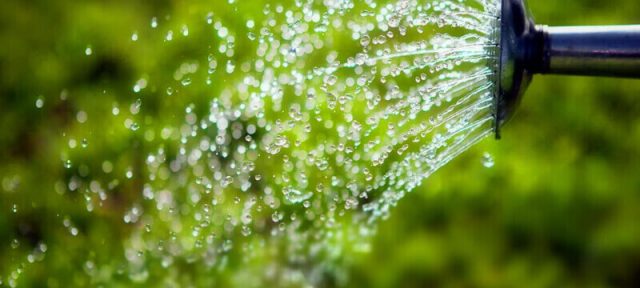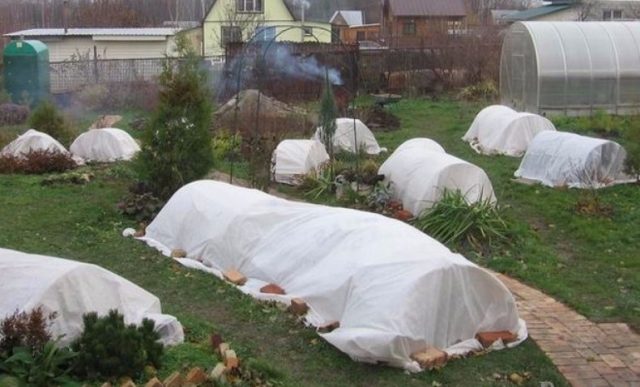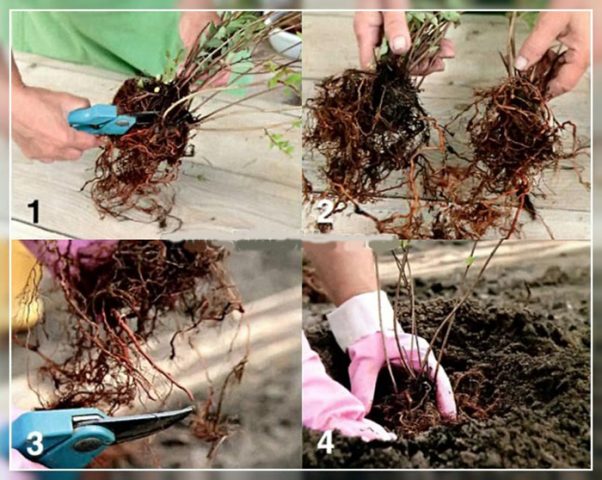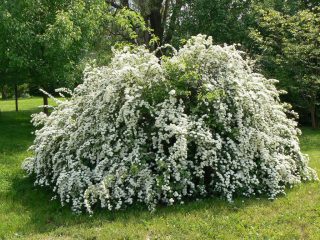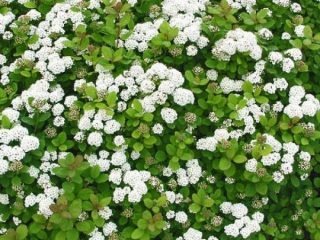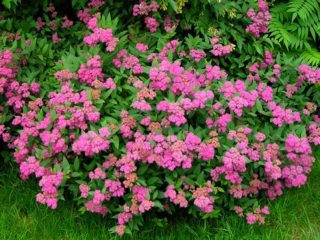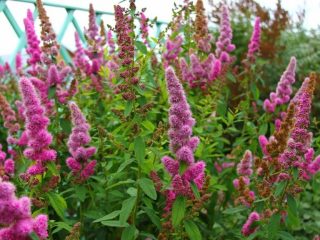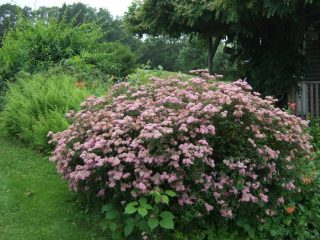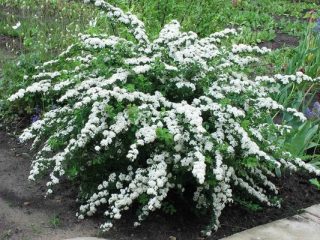Content
Spiraea plumifolia is one of the many species of this ornamental shrub of the Rosaceae family. Thanks to its very beautiful flowering, it is often planted to decorate parks, gardens, and personal plots. It is quite frost-resistant and undemanding to care, so it is grown by both experienced gardeners and beginners.
Description of plum-leaved spirea
Spiraea plumifolium is a rather tall, spreading shrub. It grows naturally in China, Japan and Korea. It is used as elements of landscape design in many countries, including Russia.
Spiraea plumifolia is shown in the photo below:
The main characteristics of plum-leaved terry spirea (Plena) are given in the table.
Parameter | Meaning |
Plant type | Deciduous shrub |
Height | Up to 2 m |
Crown size | Up to 2 m |
Escapes | Thin, flexible, rod-like |
Leaves | Bright green, oval-oblong, with a pointed end, pubescent on the reverse side. In autumn the color turns orange or red-brown |
Flowers | Snow-white, double, collected in umbrella-type inflorescences of 3-6 pieces, framed by a rosette of small leaves |
Flowering time | April May |
Spiraea plumifolia in landscape design
Spiraea plumifolia can be used in landscape design both in group and single plantings. The shrub is often used as a tapeworm, as a design element in a Japanese garden. Can be used to create hedges, design roads, alleys, lawns, rock gardens. Often used for industrial landscaping of streets, enterprise areas, healthcare facilities, and children's institutions.
Planting and care
In order for plum-leaved spirea to grow well and delight with abundant flowering for many years, you need to choose a suitable place for it. Subsequent care of the shrub is quite simple and will not cause problems even for an inexperienced gardener.
Preparation of planting material and site
Spiraea plumifolia is a spring-flowering plant. Therefore, it can only be planted in the fall, in September. To plant plum-leaved spirea on your site, you can use the vegetative method by rooting cuttings or cuttings from bushes of this plant taken from friends. However, most gardeners purchase seedlings of this shrub in specialized stores or nurseries.
As a rule, they are sold in special containers or with clay coating the roots. It is necessary to examine them carefully. The seedling should look healthy, have 2-3 tap roots and a sufficient number of lobes.
The landing site must be selected and prepared in advance. Spiraea plumifolium, like most other representatives of this species, is a light-loving plant. To plant it, you need to choose an open place with plenty of sunlight, light partial shade is allowed.The soil should be loose, light and breathable, with a neutral or slightly acidic reaction. Spiraea plum-leaved does not tolerate calcareous soils. It is better to choose a place with moderate humidity; low-lying and swampy areas are not suitable for this shrub.
Therefore, you should avoid places exposed to cold north winds and drafts.
Planting pits for seedlings must be prepared in advance, 2-3 weeks before planting. Their volume is selected taking into account the root system of the seedling; the holes should be at least 1/3 larger. If the soil is unsuitable, the holes need to be approximately 3 times larger. This will allow the spirea root system to develop in specially prepared soil. A depth of 0.7 m is sufficient. Drainage made of coarse crushed stone, pieces of brick or stones must be laid at the bottom. A small mound of earth is poured over the drainage.
The excavated soil is preserved. To increase fertility and looseness, peat, humus and sand are added to it; a small amount of superphosphate will not be superfluous. If necessary, the soil can be completely replaced with a more suitable one.
Landing rules
It is advisable to choose a cloudy, rainy day for planting. The seedling is placed vertically in the planting hole, straightening the roots along the earthen mound. The root collar must be leveled with the surface of the earth. If necessary, the height of the earthen hill can be increased or decreased. Having leveled the seedling in height, cover its roots with prepared nutrient soil, slightly compacting it so that there is no layer of air left in the roots.Then the seedling must be watered abundantly.
Watering and fertilizing
Quite often, gardeners neglect measures to care for spirea, treating it according to the “plant and forget” principle. Indeed, this plant has good endurance and often develops well even without care. However, plum-leaved spirea can fully reveal all its decorative qualities only when certain activities are performed.
The shrub is drought-resistant, and, as a rule, it is not watered, since rain is enough for the plant. Watering is recommended only in the summer months, during the driest period. At this time, the root zone of plum-leaved spirea is watered, using 1.5-2 buckets of water for each bush.
For good growth, flowering and preparation for winter, plum leaf spirea is fed three times:
- In early spring, use nitrogen-containing fertilizers or organic matter to stimulate shoot growth and rapid growth of green mass.
- Before flowering, use complex mineral fertilizers.
- At the end of summer, potassium and phosphorus fertilizers.
Trimming
Pruning plum-leaved spirea allows you to stimulate the growth of young shoots and rejuvenate the bush. Often, shrubs are trimmed for decorative purposes, giving it a certain geometric shape. You can trim bushes that have reached the age of 3-4 years. It is also necessary to carry out sanitary pruning regularly, removing broken and dried branches.
The following types of pruning are recommended for spirea:
- Stimulating. Trimming lignified stems at a height of 25-30 cm stimulates the growth of a large number of lateral shoots in spirea. At the same time, the density of the bush increases.
- Rejuvenating. It is carried out in the fall for old bushes, as well as in case of severe pest damage or frost. In this case, the shoots are completely cut off at ground level, leaving no stumps. In the spring, the spirea bush actually begins to grow anew from the buds located near the root collar, using the existing root system.
- Formative. Carry out throughout the season to maintain the desired crown shape. Spiraea tolerates pruning well and grows quickly, so it is usually cut several times a season.
Preparing for winter
Spiraea plum-leaved is poorly adapted to frost and can only winter in the southern regions without shelter. Often, not only young shoots freeze, but also old, lignified ones. The root system also suffers from severe frosts. For the winter, the root zone of plum-leaved spirea must be covered with a thick layer of mulch made from sawdust, tree bark or fallen leaves.
A shelter is usually built around the spirea, which is a wooden frame covered with parchment or other covering material.
Reproduction
Spiraea plumifolia, like most other species of this shrub, can be propagated in the following ways:
- seeds;
- cuttings;
- layering;
- dividing the bush.
The seed method is used to propagate spirea quite rarely, since when used, the plant does not retain varietal characteristics. Vegetative methods do not have this drawback, and therefore are used much more often.
Cuttings are a fairly common method of propagating plum-leaved spirea.Cuttings are cut in September from annual vertical shoots. Each of them must have at least 5 leaves. The lower sheets are removed, the upper ones are cut in half to reduce the evaporation of moisture from the surface of the sheet plate. Sections of cuttings are kept for 12 hours in Epin's solution, then powdered with Kornevin and planted at an angle of 45° in a container with wet sand.
The container is placed under film in a warm, shaded place. In the future, they are sprayed regularly to maintain constant humidity. In 4-8 weeks, spirea cuttings will take root. After this, they are planted in separate containers, and in the spring they are planted in a greenhouse for growing. By autumn, the seedlings will have a developed root system, after which they can be planted in a permanent place.
Layerings from the mother bush of plum-leaved spirea are quite easy to obtain. To do this, you need to select a flexible long side shoot, bend it to the ground, secure it with a wire clamp and sprinkle it with earth. Regular watering of this place will lead to the rooting of the allocated shoot, which will take root and sprout its own sprouts.
It must overwinter together with the mother bush. It will be possible to separate the cuttings and the mother shoot in the spring by transplanting the separated plant into a greenhouse for independent growth. In the fall, you can plant a seedling in a prepared place.
Dividing the bush is the easiest and fastest method of propagating plum-leaved spirea. It needs to be divided in the fall, in September. It is better to use young plants that have reached the age of 3-5 years for this. It is possible to divide old spirea bushes, but this is a more labor-intensive task. The bush is completely dug up. The root system is washed with water from a hose. The easiest way to divide it is with garden pruners.
Usually the bush is divided into 3-4 parts, making sure that each division has several developed shoots and good roots. After this, parts of the bush are transplanted into prepared holes in the same way as ordinary seedlings.
Diseases and pests
Spiraea plumifolia rarely gets sick. Ungroomed bushes may develop gray rot or spotting. This is due to increased humidity inside the bush. To prevent the disease, it is necessary to carry out sanitary pruning in a timely manner, remove excessive thickening and avoid getting water on the leaves when watering. If the disease does begin, the affected shoots should be immediately cut out and burned, and the bushes should be treated with fungicides.
In the fall, all fallen leaves from diseased bushes must be collected and burned, since fungal spores can overwinter in them.
Insect pests are found infrequently on Spiraea plumifolium. The greatest danger to bushes is aphids, spider mites and leaf rollers. They are combated by spraying the bushes with various chemical and biological preparations, such as Pirimor, Aktelik, etc.
Conclusion
Spiraea plumifolium is an excellent ornamental shrub that can decorate any landscape. It looks equally impressive in individual and group plantings. Blooming spirea is the real queen of the garden. It is also important that the plant is very unpretentious. It gets along well with any neighbors in the garden, and even a novice gardener can handle its care.


